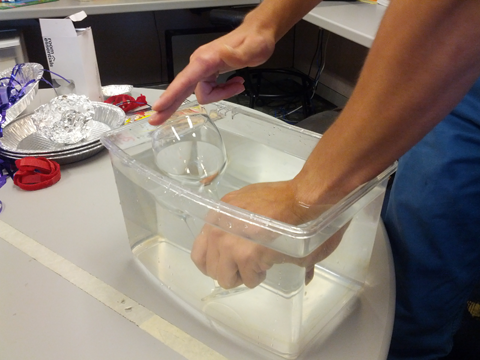Inverted Wineglass Harp
The “wineglass harp” is a classic demonstration of two phenomena: resonance, and why you don’t take young kids to nice restaurants. But with a few simple materials, you can perform a neat new take on this classic experiment at home (and without disrupting anyone’s dinner conversation!)
What You Need
- A wineglass that's capable of "singing" (thin crystal is best, but many different kinds can work with practice)
- An empty fish tank, aquarium, or other large container that can accommodate the entire glass
What to Do
1. First, get some practice making the glass “sing”. Hold the glass by the base, wet your finger or fingers, and run them around the glass’ rim. Change your pressure and speed until you can elicit a clear, continuous note from the glass.
2. Once you’ve got this down, fill your large container ALMOST to the brim with water (remember Archimedes' principle!). Holding the glass by the stem or base, submerge it about halfway into the tank, right-side-up.
3. With your other hand, ‘play’ the rim of the glass while it’s submerged.
4. Move the glass up and down in the water, tilt it, and observe the different notes it plays; try to play a song!

What's Going On?
When your finger slides around the rim, it’s putting energy into the glass through friction; you can think of it "sticking" and then "slipping" on a very small scale, many times per second. The energy you apply to get your finger to "slip" again vibrates the glass, and the vibrating glass then transfers the energy to the air to create the sound wave you hear. When you put the glass in water (or put water in the glass), the water can vibrate with the glass. Since the water-glass system has greater mass than the glass by itself, its resonant frequency (the rate it vibrates best at) is lower, like in a xylophone, where larger bars play lower notes.
Apply It!
Try filling the glass to a certain level and playing it, without submerging it. Next, empty the glass and try to find the same note by submerging it. What do you notice? Try turning the glass upside-down, trapping air in it before you submerge it. How does it affect the pitch?
-Stephen Skolnick














